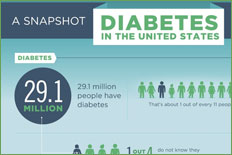Health Centers > Diabetes Center > Chronic Complications of Diabetes > Skin and Mucous membrane complications
Skin and Mucous membrane complications
Chronic pyogenic infections of the skin may occur, especially in poorly controlled diabetic patients. Eruptive xanthomas can result from hypertriglyceridemia, associated with poor glycemic control. An unusual lesion termed necrobiosis lipoidica diabeticorum is usually located over the anterior surfaces of the legs or the dorsal surfaces of the ankles. They are oval or irregularly shaped plaques with demarcated borders and a glistening yellow surface and occur in women two to four times more frequently than in men.
Diabetes Chronic Complications
Ocular complications
L Diabetic cataracts
L Diabetic retinopathy
L Glaucoma
Diabetic Nephropathy
L Microalbuminuria
L Progressive diabetic nephropathy
Diabetic Neuropathy
L Peripheral neuropathy
L Autonomic neuropathy
Cardiovascular complications
L Heart disease
L Peripheral vascular disease
Skin and Mucous membrane complications
Special Situations
Prognosis
"Shin spots" are not uncommon in adult diabetics. They are brownish, rounded, painless atrophic lesions of the skin in the pretibial area. Candidal infection can produce erythema and edema of intertriginous areas below the breasts, in the axillas, and between the fingers. It causes vulvovaginitis in most chronically uncontrolled diabetic women with persistent glucosuria and is a frequent cause of pruritus.
While antifungal creams containing miconazole or clotrimazole offer immediate relief of vulvovaginitis, recurrence is frequent unless glucosuria is reduced.
F. SPECIAL SITUATIONS
1. Insulin replacement during surgery - A prospective trial in surgical ICU patients reported that aggressive treatment of hyperglycemia (blood glucose > 110 mg/dL) reduced mortality and morbidity. Only a small number of persons in this study (204 of 1548) had a diagnosis of diabetes preoperatively, and so it seems that hyperglycemia per se (and not complications of diabetes) was an important cause of postoperative complications. Keeping blood glucose values as close to normal as possible is therefore the goal in the postsurgical patient in the ICU.
When surgical patients leave the ICU, target glucose values between 100 mg/dL and 200 mg/dL may be appropriate, although this view is based on clinical observations rather than conclusive evidence. The same investigators performed a similar prospective trial in 1200 medical ICU patients and reported that aggressive treatment of hyperglycemia reduced morbidity (decreased acquired renal injury and increased early weaning from mechanical ventilation) but not mortality. Again, as in the surgical ICU study, only a small number of persons (16.9%) had a diagnosis of diabetes at admission. One of the inclusion criteria for the study was that patients would only be enrolled if they were likely to stay in the ICU for 3 days or longer. Some patients stayed in the ICU less than 3 days, and in that subgroup, intensive insulin therapy was associated with increased mortality. On the other hand, patients who stayed in the ICU for 3 days or longer had reduced mortality (and morbidity). Clearly, further studies are needed to address this observation.
During major surgery and in the immediate recovery period in patients with type 1 diabetes - and in most patients with type 2 diabetes - 5% dextrose in physiologic saline containing 20 mEq of potassium chloride should be infused intravenously at a rate of 100-200 mL/h with regular human insulin (25 units/250 mL 0.9% saline) into the intravenous tubing at a rate of 1-3 units/h. The patient's blood glucose should be monitored every hour initially and the rates of insulin or dextrose adjusted to maintain blood glucose values between 80 mg/dL and 110 mg/dL in the ICU and 100-200 mg/dL on the wards.
The Hypoglycemic States
Spontaneous hypoglycemia in adults is of two principal types: fasting and postprandial. Symptoms begin ...
Type 2 patients facing minor surgical procedures not requiring general anesthesia who have previously been controlled on oral agents or diet alone do not generally require insulin infusions. Glucose-containing solutions should be avoided during surgery in these patients, and blood glucose levels should be monitored every 4 hours. Regular human insulin or one of the rapid-acting insulin analogs should be administered subcutaneously if needed to maintain blood glucose below 200 mg/dL.
2. Pregnancy and the diabetic patient - Several features distinguish the management of diabetics during pregnancy from the general therapy of diabetes. These include the following: (1) Oral hypoglycemic agents are contraindicated. (2) Weight reduction is not advised, since fetal nutrition can be adversely affected. (3) Intensive insulin therapy with frequent self-monitoring of blood glucose is generally recommended to improve the likelihood of having healthy normal babies. Every effort should be made, utilizing multiple injections of insulin or a continuous infusion of insulin by pump, to maintain near-normalization of fasting and preprandial blood glucose values while avoiding hypoglycemia. Glycohemoglobin should be maintained in the normal range.
Since many diabetic pregnancies persist beyond the expected term - or because the infants are usually large and hydramnios may be present - it has been suggested that the baby should be delivered early (at 37-38 weeks), especially if glycemic control during pregnancy has been inadequate (eg, glycohemoglobin > 10%). There is a present trend away from elective cesarean section and toward induction of labor.
Prognosis
The DCCT showed that the previously poor prognosis for as many as 40% of patients with type 1 diabetes is markedly improved by optimal care. DCCT participants were generally young and highly motivated and were cared for in academic centers by skilled diabetes educators and endocrinologists who were able to provide more attention and services than are usually available. Improved training of primary care providers may be beneficial.
For type 2 diabetes, the UKPDS documented a reduction in microvascular disease with glycemic control, although this was not apparent in the obese subgroup. Cardiovascular outcomes were not improved by glycemic control, although antihypertensive therapy showed benefit in reducing the number of adverse cardiovascular complications as well as in reducing the occurrence of microvascular disease among hypertensive patients. In patients with visceral obesity, successful management of type 2 diabetes remains a major challenge in the attempt to achieve appropriate control of hyperglycemia, hypertension, and dyslipidemia. Once safe and effective methods are devised to prevent or manage obesity, the prognosis of type 2 diabetes with its high cardiovascular risks should improve considerably.
In addition to poorly understood genetic factors relating to differences in individual susceptibility to development of long-term complications of hyperglycemia, it is clear that in both types of diabetes, the diabetic patient's intelligence, motivation, and awareness of the potential complications of the disease contribute significantly to the ultimate outcome.
Bibliography
American Association of Diabetes Educators http://www.aadenet.org/
American Diabetes Association http://www.diabetes.org/home
American Dietetic Association http://www.eatright.org
Abraira C et al: Intensive insulin therapy in patients with type 2 diabetes: implications of the Veterans Affairs (VA CSDM) feasibility trial. Am Heart J 1999;138:S360. [PMID: 10539798]
American Diabetes Association Position Statement: Diabetes nephropathy. Diabetes Care 2004;27(Suppl 1):S79. [PMID: 14693434]
American Diabetes Association Position Statement: Preventive foot care in people with diabetes. Diabetes Care 2004;27 (Suppl 1):S63. [PMID: 14693928]
American Diabetes Association: Standards of Medical Care in Diabetes. Diabetes Care 2006;29:476. [PMID: 16482699]
Atkinson MA et al: Type 1 diabetes: new perspectives on disease pathogenesis and treatment. Lancet 2001;358:221. [PMID: 11476858]
DeFronzo RA et al: Effects of exenatide (exendin-4) on glycemic control and weight over 30 weeks in metformin-treated patients with type 2 diabetes. Diabetes Care 2005;28:1092. [PMID: 15855572]
Diabetes Prevention Trial - Type 1 Diabetes Study Group: Effects of insulin in relatives of patients with type 1 diabetes mellitus. N Engl J Med 2002;346:1685. [PMID: 12037147]
Effect of intensive blood-glucose control with metformin on complications in overweight patients with type 2 diabetes (UKPDS 34). UK Prospective Diabetes Study (UKPDS) Group. Lancet 1998;352:854. [PMID: 9742977]
Efficacy of atenolol and captopril in reducing risk of macrovascular and microvascular complications in type 2 diabetes: UKPDS 39. UK Prospective Diabetes Study Group. BMJ 1998;317: 713. [PMID: 9732338]
Frank RN: Diabetic retinopathy. N Engl J Med 2004;350:48. [PMID: 14702427]
Gaede P et al: Multifactorial intervention and cardiovascular disease in patients with type 2 diabetes. N Engl J Med 2003; 348:383. [PMID: 12556541]
Genuth S et al: Expert Committee on the Diagnosis and Classification of Diabetes Mellitus: Follow-up report on the diagnosis of diabetes mellitus. Diabetes Care 2003;26:3160. [PMID: 14578255]
Harris R et al: Screening adults for type 2 diabetes: a review of the evidence for the U.S. Preventive Services Task Force. Ann Intern Med 2003;138:215. [PMID: 12558362]
Hebel G et al: Hypoglycemia: pathophysiology and treatment. Endocrinol Metab Clin North Am 2000;29:725. [PMID: 11149159]
Holst JJ et al: Role of incretin hormones in the regulation of insulin secretion in diabetic and nondiabetic humans. Am J Physiol Endocrinol Metab 2004;287:E199. [PMID: 15271645]
Intensive blood-glucose control with sulphonylureas or insulin compared with conventional treatment and risk of complications in patients with type 2 diabetes (UKPDS 33). UK Prospective Diabetes Study (UKPDS) Group. Lancet 1998;352: 837. [PMID: 9742976]
Juvenile Diabetes Foundation http://www.jdf.org/index.html
Knowler WC et al: Reduction in the incidence of type 2 diabetes with lifestyle intervention or metformin. N Engl J Med 2002;346:393. [PMID: 11832527]
Lipshultz LI et al: Treatment of erectile dysfunction in men with diabetes. JAMA 1999;281:465. [PMID: 9952210]
Ohkubo Y et al: Intensive insulin therapy prevents the progression of diabetic microvascular complications in Japanese patients with non-insulin-dependent diabetes mellitus: a randomized prospective 6-year study. Diabetes Res Clin Pract 1995;28:103. [PMID: 7587918]
Owens DR et al: Insulins today and beyond. Lancet 2001;358: 739. [PMID: 11551598]
Poncelet AN: Diabetic polyneuropathy. Risk factors, patterns of presentation, diagnosis, and treatment. Geriatrics 2003;58: 16. [PMID: 12813869]
Rosenstock J et al: Inhaled insulin improves glycemic control when substituted for or added to oral combination therapy in type 2 diabetes: a randomized, controlled trial. Ann Intern Med 2005;143:549. Summary for patients in: Ann Intern Med 2005;143:I28 [PMID: 16230721]
Screening for type 2 diabetes mellitus in adults: recommendations and rationale. Ann Intern Med 2003;138:212 [PMID: 12558361]
Setter SM et al: Metformin hydrochloride in the treatment of type 2 diabetes mellitus: a clinical review with a focus on dual therapy. Clin Ther 2003;25:2991. [PMID: 14749143]
Shichiri M et al: Long-term results of the Kumamoto Study on optimal diabetes control in type 2 diabetic patients. Diabetes Care 2000;23(Suppl 2):B21 [PMID: 10860187]
Snow V et al: The evidence base for tight blood pressure control in the management of type 2 diabetes mellitus. Ann Intern Med 2003;138:587 [PMID: 12667031]
Stumvoll M et al: Clinical features of insulin resistance and beta cell dysfunction and the relationship to type 2 diabetes. Clin Lab Med 2001;21:31 [PMID: 11211936]
Tight blood pressure control and risk of macrovascular and microvascular complications in type 2 diabetes: UKPDS 38. UK Prospective Diabetes Study Group. BMJ 1998;317: 703. [PMID: 9732337]
Van den Berghe G et al: Intensive insulin therapy in the critically ill patient. N Engl J Med 2001;345:1359. [PMID: 11794168]
Van den Berghe G et al: Intensive insulin therapy in the medical ICU. N Engl J Med 2006;354:449. [PMID: 16452557]
Vijan S et al: Treatment of hypertension in type 2 diabetes mellitus: blood pressure goals, choice of agents, and setting priorities in diabetes care. Ann Intern Med 2003;138:593 [PMID: 12667032]
Yki-Jarvinen H: Thiazolidinediones. N Engl J Med 2004;351: 1106. [PMID: 15356308]
Yusuf S et al: Effects of an angiotensin-converting-enzyme inhibitor, ramipril, on cardiovascular events in high-risk patients. The Heart Outcomes Prevention Evaluation Study Investigators. N Engl J Med 2000;342:145. Erratum in: 2000;342:1376. N Engl J Med 2000;342:748 [PMID: 10639539]
Wajchenberg BL: Subcutaneous and visceral adipose tissue: their relation to the metabolic syndrome. Endocr Rev 2000;21: 697. [PMID: 11133069]
Weissberg-Benchell J et al: Insulin pump therapy: a meta-analysis. Diabetes Care 2003;26:1079 [PMID: 12663577]
Zinman B et al: American Diabetes Association: Physical activity/exercise and diabetes. Diabetes Care 2004;27(Suppl 1):S58. [PMID: 14693927]


